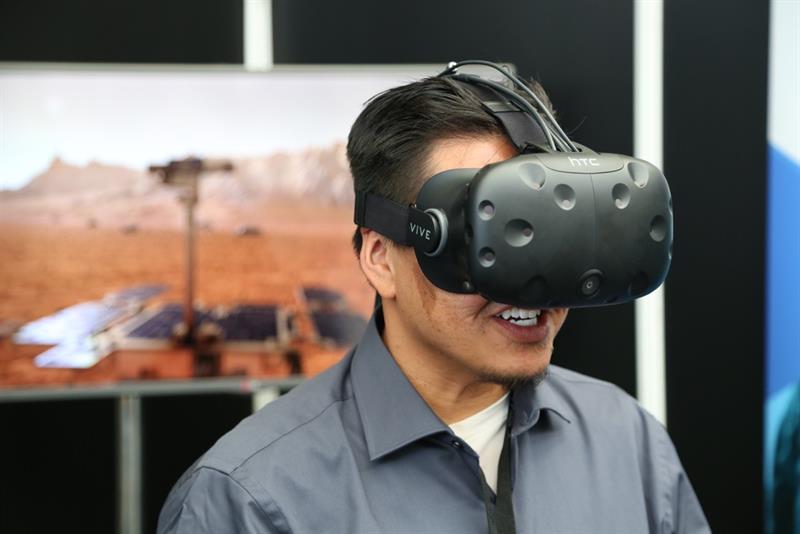Thanks to the new government commissioned review on industrial digitisation, which says the manufacturing sector could unlock £455bn over the next decade if it embraces the fourth industrial revolution, technologies like virtual reality (VR) and augmented reality (AR) are now even higher up on the manufacturing agenda.
The use of VR and AR in the manufacturing sector is still a relatively new field that needs demystifying, with many no doubt fearing investment in these new technologies comes with a vast price tag. And yet those manufacturers that are innovative enough to take the leap are finding that VR and AR create unexpected efficiencies.

Manufacturers often have an enviable wealth of precious assets – like versatile CAD, 3D scans and GIS data – at their fingertips. These assets aren’t often used beyond their intended purpose and yet they have the potential to aid digital transformation in a way that benefits multiple disciplines across an entire enterprise.
This new type of thinking is being employed by a small but bold handful of manufacturers. They are using bleeding-edge VR and AR applications to demo products so that they can be presented more powerfully by being experienced in context… albeit a virtual context. If you manufacture aeronautic products, for example, it’s almost impossible to let prospective customers experience those products in their rightful context. And yet, through VR, prospects can be (virtually) transported from the conference room floor into the skies and beyond; perhaps even into outer space.
It’s no secret that VR and AR create the wow factor. So it’s no wonder the VR/AR approach is proving to be a crowd-pleaser at trade conferences. But what may be more surprising is that this tactic can furnish manufacturers with a whole new content pipeline worthy of the fourth industrial revolution. What’s more, it can be done without a daunting level investment.
A manufacturer can create VR content very efficiently by digitally transforming their existing data assets, rather than building from scratch. Assets like CAD (computer aided design) 3D data are readily available throughout a manufacturer’s pipeline and they can be used as the VR experience’s building blocks.
The end result is not only a memorable trade event experience that drives increased engagement; this approach also creates a suite of ‘live’ assets that helps shift content workflows from linear to real-time. And it’s all because VR experiences are heavily dependent on game engines: an amazing piece of software, long used by the video game industry, that renders content sequences in an instant. If it weren’t for game engines, video game players wouldn’t be able to control their avatars in real-time. So game engines are the magic ingredient that give VR experiences their real-time interactivity.
Game engines are now so sophisticated that they’re capable of taking assets like CAD data and displaying them in near photo-real quality whilst simultaneously allowing users to interact with virtual products in real-time. Combine this with a powerfully immersive virtual world and you get a formidable tool for communicating business stories and much, much more.
The benefit of involving a VR game engine in an enterprise pipeline is that if someone in the business needs a particular piece of content, whether it be for a trade show or a virtual manufacturing simulation, that piece of content can be rendered out at the flick of a switch through the game engine, rather than following the old-school, expensive and time-consuming content approach of ‘offline’ editing.

This is how digital transformation of existing assets can be combined with a VR game engine to benefit departments across an entire manufacturing business: from virtual simulations to new product innovation, training, prototyping, design, marketing and sales. Just imagine how much more engaging and effective a training session would be if trainees could learn through an immersive experience that was created with minimal cost, time and resource, using assets that were already in place thanks to the original VR experience.
So although VR is most strongly associated with out-of-this-world immersive experiences, it can additionally be weaponised to generate near-instant content and invaluable applications for a wide array of disciplines and departments within a single enterprise. And that must surely capture the true spirit of the fourth industrial revolution.
If digitising assets for VR game engines is such a win-win for the entire business, it begs the question: why aren’t more manufacturers using their assets in this way? The problem is, because departments usually work in silo, stakeholders within the same business often don’t know what assets exist or how to use them. So although VR experiences may be an obvious solution for marketing and sales, those departments may not know that CAD data can be the secret to efficient VR creation. Similarly, once the experience has been built, its constituent parts may not be recognised as useful by other areas of the business.
So let’s break down the silos and start investigating the brave new world of enterprise VR solutions. Let’s begin by making sure that every department across every business is aware that VR can be as practical as it is entertaining. The whole business will thank you for it and it might just be the key that unlocks that aforementioned £455bn.




